Country Population 156,720 (2010) Province Province of Cagliari University University of Cagliari Area 85.45 km2 | Region Mayor Massimo Zedda (Left) | |
Points of interest Museo archeologico nazionale, Cagliari Cathedral, Teatro Lirico | ||
Cagliari ( Sardinian: ; Latin: ) is an Italian municipality and the capital of the island of Sardinia, an Autonomous Region of Italy. Cagliaris Sardinian name Casteddu literally means castle. It has nearly 150,000 inhabitants, while its metropolitan area (including Cagliari and 15 other municipalities) has more than 422,000 inhabitants. Cagliari is the 26th largest city in Italy and the largest city on the island of Sardinia.
Contents
- Map of Cagliari
- Sites to see in cagliari
- Cagliari travel guide tour map history weather
- History
- Geography
- Economy
- Main sights
- Culture
- Museums and Galleries
- Cagliari cuisine
- References
Map of Cagliari
An ancient city with a long history, Cagliari has seen the rule of several civilizations. Under the buildings of the modern city there is a continuous stratification attesting to human settlement over the course of some five thousand years, from the Neolithic to today. Historical sites include the prehistoric domus de janas, very damaged by cave activity, a large Carthaginian era necropolis, a Roman era amphitheater, a Byzantine basilica, three Pisan-era towers, and a strong system of fortification that made the town the core of Spanish Habsburg imperial power in the western Mediterranean sea. Its natural resources have always been its sheltered harbor, the often powerfully fortified hill of Monti Castru, the modern Casteddu, the salt from its lagoons, and, from the hinterland, wheat from the Campidano plain and silver and other ores from the Iglesiente mines.
Sites to see in cagliari
Cagliari was the capital of the Kingdom of Sardinia from 1324 to 1848, when Turin became the formal capital of the kingdom that in 1861 became the Kingdom of Italy). Today the city is a regional cultural, educational, political and artistic centre, known for its diverse Art Nouveau architecture and several monuments. It is also Sardinias economic and industrial hub, having one of the biggest ports in the Mediterranean sea, an international airport, and the 106th highest income level in Italy (among 8,092 comuni), comparable to that of several northern Italian cities.
Cagliari travel guide tour map history weather
It is also the seat of the University of Cagliari, founded in 1607, and of the Primate Roman Catholic archdiocese of Sardinia, since the 5th century AD.
History
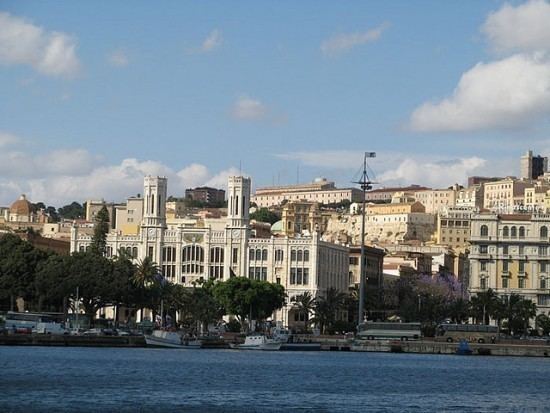
Cagliari has been inhabited since ancient times. It occupies a favourable position between the sea and a fertile plain and is surrounded by two swamps (which aids defense against attacks from the inland). There are high mountains nearby, to which people could evacuate if the settlement had to be given up. Relics of prehistoric inhabitants were found in the hill of Monte Claro (Monte Claro culture) and in Cape SantElia (several domus de janas).
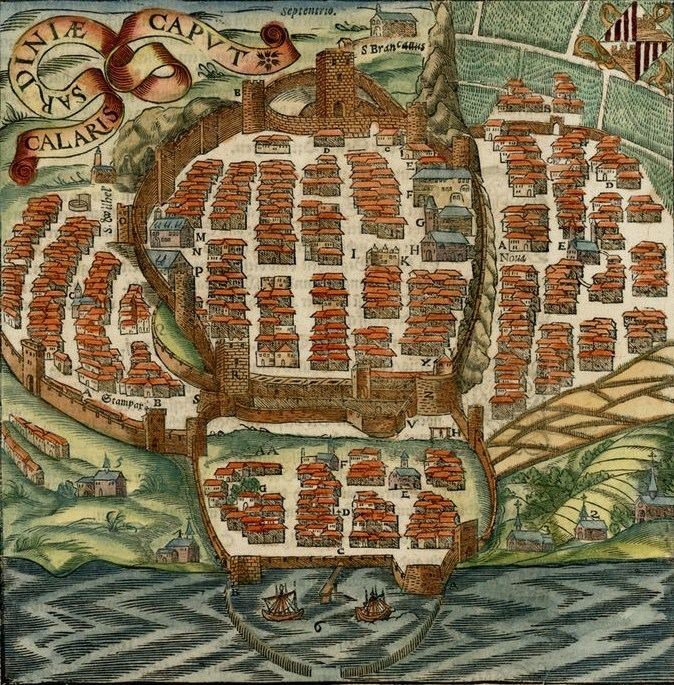
Karalis was established around the 8th/7th century BC as one of a string of Phoenician colonies in Sardinia, including Tharros. Its founding is linked to its position along communication routes with Africa as well as to its excellent port. The Phoenician settlement was located in the Stagno di Santa Gilla, west of the present centre of Cagliari. This was also the site of the Roman Portus Scipio, and when Arab pirates raided the area in the 8th century it became the refuge for people fleeing from the city. Other Phoenician settlements have been found at Cape SantElia.
In the 5th century BC Carthage took control of Sardinia, and Cagliari grew substantially under their domination, as testified by the large Tuvixeddu necropolis and other remains. Cagliari was a fortified settlement in what is now the modern Marina quarter, with an annexed holy area in the modern Stampace.
Sardinia and Cagliari came under Roman rule in 238 BC when the Romans defeated the Carthaginians. No mention of it is found on the occasion of the Roman conquest of the island, but during the Second Punic War it was the headquarters of the praetor, T. Manlius, from whence he conducted his operations against Hampsicora and the Carthaginians. At other times it was also the Romans chief naval station on the island, and the residence of the praetor.
Florus calls it the urbs urbinum, or capital of Sardinia, and represents it as taken and severely punished by Gracchus, but this statement is wholly at variance with Livys account of the wars of Gracchus, in Sardinia, according to which the cities were faithful to Rome, and the revolt was confined to the mountain tribes. In the Civil War between Caesar and Pompey, the citizens of Caralis were the first to declare in favor of the former, an example soon followed by the other cities of Sardinia; and Caesar himself touched there with his fleet on his return from Africa. A few years later, when Sardinia fell into the hands of Menas, the lieutenant of Sextus Pompeius, Caralis was the only city which offered any resistance, but was taken after a short siege.
Cagliari continued to be regarded as the capital of the island under the Roman Empire, and though it did not become a colony, obtained the status of Municipium.
Remains of Roman public buildings were found to the west of Marina in Piazza del Carmine. There was an area of ordinary housing near the modern Via Roma, and richer houses on the slopes of the Marina distinct. The amphitheatre is located to the west of the Castello.
A Christian community is attested in Cagliari at least as early as the 3rd century, and by the end of that century the city had a Christian bishop. In the middle decades of the 4th century bishop Lucifer of Cagliari was exiled because of his opposition to the sentence against Athanasius of Alexandria at the Synod of Milan. He was banished to the desert of Thebais by the emperor Constantius II.
Claudian describes the ancient city of Karalis as extending to a considerable length towards the promontory or headland, the projection of which sheltered its port. The port affords good anchorage for large vessels, but besides this, which is only a well-sheltered standby, there is a large salt-water lake or lagoon, called the Stagno di Cagliari, adjoining the city and communicating by a narrow channel with the bay, which appears from Claudian to have been used in ancient times as an inner harbor or basin. The promontory adjoining the city is evidently that noticed by Ptolemy (), but the Caralitanum Promontorium of Pliny can be no other than the headland, now called Capo Carbonara, which forms the eastern boundary of the Gulf of Cagliari and the southeast point of the whole island. Immediately off it lay the little island of Ficaria, now called the Isola dei Cavoli.
After the fall of the Western Roman Empire Cagliari fell, together with the rest of Sardinia, into the hands of the Vandals, but appears to have retained its importance throughout the Middle Ages.
Geography
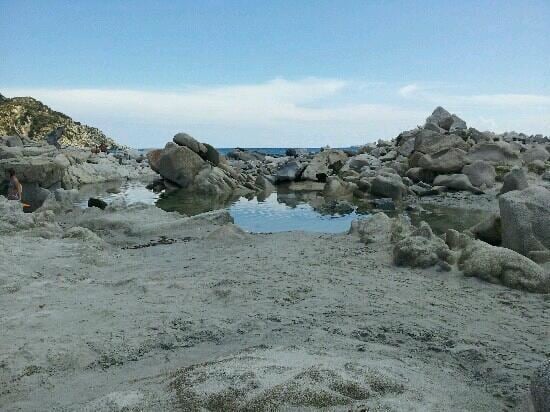
The city of Cagliari is situated in the south of Sardinia, overlooking the center of the eponymous gulf, also called Golfo degli Angeli ("Bay of Angels") after an ancient legend. The city is spread over and around the hill of the historic district of Castello and nine other limestone hills of the middle-to-late Miocene, unique heights of a little more than 100 metres (330 ft) above sea level on the long plains of Campidano. The plain is actually a Graben formed during the Alpine orogeny of the Cenozoic, which separated Sardinia from the European continent, roughly where the Gulf of Lion is now. The Graben filled in the course of tectonic movements associated with the breakup of the ancient island Paleozoic skeleton.
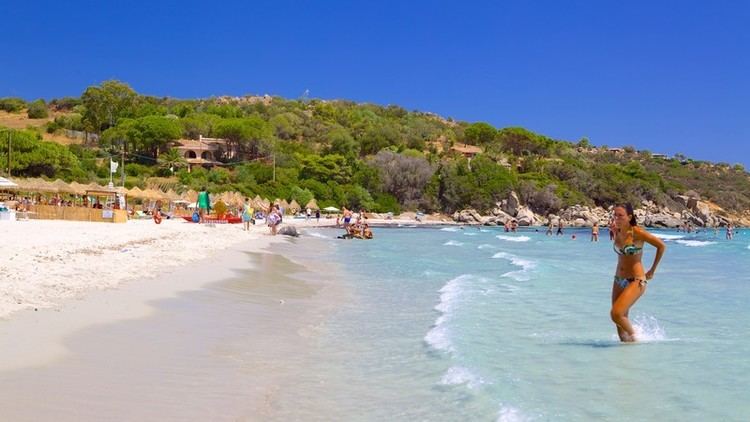
The repeated intrusion of the sea left calcareous sediments that formed a series of hills that mark the territory of Cagliari. That is where a fortified town arose near the harbor of the port, the birthplace of the city, as well as Mount Urpinu, the St. Elias hill, also known as the Sella del Diavolo ("Saddle of the Devil") for its shape, Tuvumannu and Tuvixeddu, the site of the ancient Punic and Roman necropolis, the small Bonaria hill, where the basilica stands, and the San Michele hill, with the eponymous castle on top. The modern city occupies the flat spaces between the hills and the sea to the south and southeast, along the Poetto beach, the lagoons and ponds of Santa Gilla and Molentargius, and the remains of more recent marine intrusions, in an articulate landscape with many landmarks and panoramas of the bay, the plain, and the mountains that surround it on the east (The Seven Brothers and Serpeddi) and west (the mountains of Capoterra). On the cold, clear days of winter, the snowy peaks of Gennargentu can be seen from the highest points of the city.
The city has four historic neighborhoods: Cesteddu de susu (Castello), Marina, Stampaxi (Stampace), e Biddanoa (Villanova) and several modern districts, grown when part of the ancient walls had been demolished in the middle of the 19th century, such as San Benedetto, Monte Urpinu and Genneruxi at the east, SantAvendrace at the west, Is Mirrionis/San Michele at north and Bonaria, La Palma and Poetto at the south. Another neighborhood is Pirri, former village of the Campidanu absorbed in the fast growth after the Second World War.
Economy
According to 2011 data from the Italian Ministry of Economic Affairs, the inhabitants of Cagliari returned an individual income tax per capita that was 128% of the national average, while all of Sardinia returned only 80%. The metropolitan area returned 97% of the national average. As usual, the urban area income is greater than that of boroughs or countryside, but considering all of Sardinia the figure is particularly significant.
Main sights
Considerable remains of the ancient city of Karalis are still visible, including those of the Tuvixeddu necropolis, the Roman amphitheatre, traditionally called Is centu scalas ("One hundred steps"), and of an aqueduct used to provide generally scarce water. Still visible are also some ancient cisterns of vast extent, the ruins of a small circular temple, and numerous sepulchres on a hill outside the modern town that appear to have formed the necropolis of the ancient city. The amphitheatre stages open-air operas and concerts during the summer.
The Palaeo-Christian Basilica of San Saturnino, dedicated to a martyr killed under Diocletians reign, Saturninus of Cagliari, patron saint of the city, was built in the 5th century. Of the original building the dome and the central part remain, to which two arms (one with a nave and two aisles) were added later. A Palaeo-Christian crypt is also under the church of San Lucifero (1660), dedicated to Saint Lucifer, a bishop of the city. The church has a Baroque facade with ancient columns and sculpted parts, some of which came from the nearby necropolis.
The old medieval town (called Castello in Italian, Casteddu de susu in Sardinian, "the upper castle") lies on top of a hill with a view of the Gulf of Cagliari (also known as Angels Gulf). Most of its city walls are intact and include two early 14th-century white limestone towers, the Torre di San Pancrazio and the Torre dellElefante, typical examples of Pisan military architecture. The local white limestone was also used to build the walls of the city and many other buildings, besides the towers. D. H. Lawrence, in his memoir of a voyage to Sardinia, Sea and Sardinia, that he undertook in January 1921, described the effect of warm Mediterranean sunlight on the white limestone city and compared Cagliari to a "white Jerusalem".
The cathedral was restored in the 1930s, returning the former Baroque facade into a Medieval Pisan-style facade more akin to the original appearance of the church in the 13th century. The bell tower is original. The interior has a nave and two aisles, with a pulpit (1159–1162) sculpted for the Cathedral of Pisa but later donated to Cagliari. The crypt houses the remains of martyrs found in the Basilica of San Saturno (see below). Near the cathedral is the palace of the provincial government. Before 1900 it was the islands governors palace.
The Sanctuary of Our Lady of Bonaria (from which the city of Buenos Aires, Argentina, gets its name) was built by the Catalans in 1324–1329 when they were besieging the Pisans in Castello. It has a small Gothic portal in the facade and the interior houses a wooden statue of the Madonna, which, after having been thrown off a Spanish ship, landed at the foot of Bonaria hill. Bonaria hill is also the location of the Monumental Cemetery of Bonaria.
The Chiesa della Purissima is a Catalan Gothic church built in the 16th century in the Castello distinct.
The other early districts of the town (Marina, Stampace and Villanova) retain much of their original character. In Stampace the Torre dello Sperone, another tower built by the Pisans in the late 13th-century, is located, as well as two important monumental churches: the Collegiata di SantAnna and the Chiesa di San Michele, both built in the 18th century in a baroque style. Many more churches, both old and modern, can be found throughout the city.
The Promenade Deck and the Terrazza Umberto I were designed in 1896 by the engineers Joseph Costa and Fulgenzio Setti. The entire building was built of white and yellow limestone in a classical style with Corinthian columns. It was opened in 1901. A staircase with two flights provides access from Constitution Square. It is interrupted by a covered walkway and ends beneath the Arc de Triomphe, in the Terrazza Umberto I. In 1943, during World War II, the staircase and the Arch of Triumph were severely damaged by aerial bombardment, but after the conflict they were faithfully reconstructed.
From the Terrazza Umberto I the Bastion of Santa Caterina can be accessed via a short flight of steps. Here there was once an old Dominican convent, destroyed by fire in 1800. According to tradition, the conspiracy to kill the Viceroy Camarassa in 1666 was set up in the surroundings of the monastery.
The Promenade Deck was inaugurated in 1902. At first it was used as a banqueting hall, then during the First World War as an infirmary. In the 1930s, during the period of sanctions, it was an exhibition of autarky. During World War II it served as a shelter for displaced people whose homes had been destroyed by bombs. In 1948 it hosted the first Trade Fair of Sardinia. After many years of decay, the Promenade was restored and re-evaluated as a cultural space reserved especially for art exhibitions.
The modern districts built in the late 19th and early 20th century contain examples of Art Deco architecture, as well as controversial examples of Fascist neoclassicism architecture, such as the Court of Justice (Palazzo di Giustizia) in Republic Square. The Court of Justice is near the biggest city park, Monte Urpinu, with its pine trees, artificial lakes, and a vast area with a hill. The Orto Botanico dellUniversita di Cagliari, the citys botanical garden, is also of interest.
Culture
The city has numerous libraries and is also home to the State Archive, containing thousand of handwritten documents from the foundation of the Kingdom of Sardinia (1325 AD) to the present. In addition to numerous local and university department libraries, the most important libraries are the old University Library, with thousands of ancient books, the Provincial Library, the Regional Library, and the Mediateca of the Mediterranean, which contains the municipal archive and library collection.
In the first century B.C. a famous singer and musician from Cagliari, Tigellius, lived in Rome and was satirized by Cicero and Horace. The history of Sardinian literature begins in Cagliari in the first century A.D. In the funerary monument of Atilia Pomptilla, carved into the rock of the necropolis of Tuvixeddu, poems are engraved in Greek and Latin dedicated to his dead wife. Some of them, particularly those in the Greek language, have literary merit.
The first Sardinian literary author known was Bishop Lucifer of Cagliari, who wrote severe pamphlets against the Arian heresyin the fourth century A.D. Only in the eleventh century A.D. did the first texts of an administrative nature appear in the modern Sardinian language, together with hagiographs of local martyrs written in Latin.
Life in Cagliari has been depicted by many writers, starting with the late Roman poet Claudian. In the late 16th century, the local humanist Roderigo Hunno Baeza dedicated to his town a didactic Latin poem, Caralis Panegyricus. At the beginning of the 17th century Juan Francisco Carmona wrote a hymn to Cagliari in Spanish; Jacinto Arnal De Bolea published in 1636, in Spanish, the first novel set in Cagliari, entitled El Forastero. David Herbert Lawrence wrote about the city in his Sea and Sardinia.
Modern writers connected to Cagliari include Giuseppe Dessi, Giulio Angioni, Giorgio Todde, and Sergio Atzeni, who set many of his novels and short stories, such as Bakunins Son, in ancient and modern Cagliari.
Cagliari was the birthplace or residence of the composer Ennio Porrino, of the film, theatre and TV director Nanni Loy, and of the actors Gianni Agus, Amedeo Nazzari and Pier Angeli (born Anna Maria Pierangeli).
Excluding the Roman era amphitheater, the first theater was inaugurated in Cagliari in 1767: the Teatro Zapata, later becoming the Civic Theatre. Devastated by bombing in 1943, it was recently restored, but the roof was not rebuilt, and today it serves as an open-air theatre. The Politeama Regina Margherita, inaugurated in 1859, was destroyed by fire in 1942 and never rebuilt.
Although opera had, and in part still has, a solid tradition the city, it was left without a true theater until 1993 when a new opera house, the Teatro Lirico, was inaugurated. Inside there is a music compound with a music conservatory with its own auditorium, and a music park. Cagliari is and was home to opera singers such as the tenors Giovanni Matteo Mario (Giovanni Matteo De Candia, 1810-1883) and Piero Schiavazzi (1875–1949), the baritone Angelo Romero (born 1940), the contralto Bernadette Manca di Nissa, born 1954 and the soprano Giusy Devinu (1960–2007). The Italian pop singer Marco Carta was also born in Cagliari, in 1985.
The old Teatro Massimo was only recently renovated and is now the seat of the Teatro Stabile of Sardinia. The Municipal Auditorium, in the former 17th-century church of Santa Teresa, is the seat of the Scuola di Arte Drammatica (School of Dramatic Art) di Cagliari, while the Teatro delle Saline ("Saltworks Theatre"), is home of Akroama, Teatro Stabile di Innovazione ("Permanent Theater of Innovation").
Finally, some comic and satirical theater companies are active in the city, the most well known being the "Compagnia Teatrale Lapola", which offers an urban version of the traditional campidanese comic theater.
Founded by Bepi Vigna, Antonio Serra and Michele Medda, a comic book school, the Centro Internazionale del Fumetto ("Comic Strip International Centre") has been active for several decades. Its founders invented and designed the comic characters Nathan Never and Legs Weaver.
Museums and Galleries
The Polo museale di Cagliari "Cittadella dei musei" (Citadel of Museums) is home to:
Cagliari cuisine
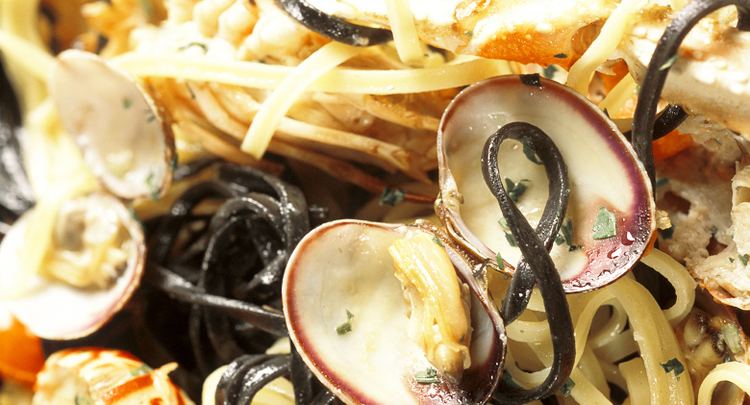
Cagayan de Oro food cultures include a variety of world cuisines influenced by the citys immigrant history. Western and Austronesian immigrants have made the city famous for pastel bread, chicharron and Hamon de Cagayan. Numerous of Chinese and Korean restaurants are also present in the city. Some mobile food vendors licensed by the city sell street food like kwek-kwek, fish balls, tempura, proven and grilled meat.
